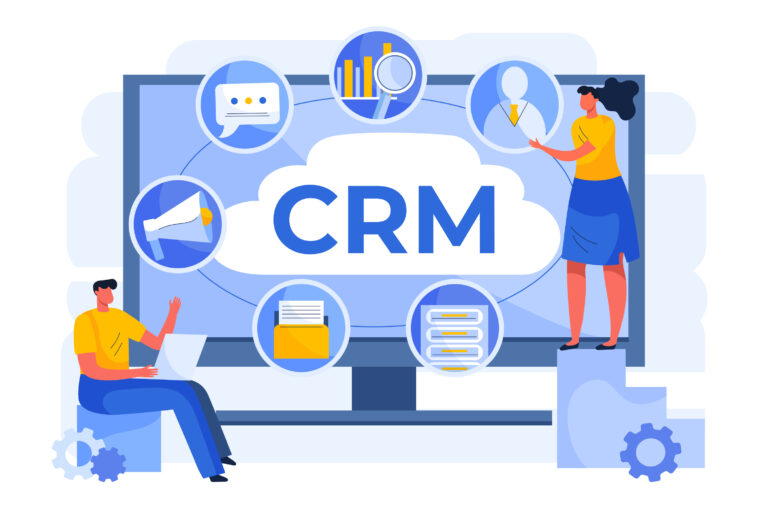What is CRM?
CRM stands for “Customer Relationship Management”. This system is a system that combines all interactions of businesses with their customers (sales, marketing, customer service, etc.) on a single platform. Therefore, it collects and analyzes customer data and allows you to make more personalized, efficient and strategic decisions using this data.
The main purpose of this software is to increase customer satisfaction, strengthen loyalty and increase business revenues. For example, you can see previous conversations with a customer, their purchase history or complaints in one place. This saves time and gives the customer a better experience.

CRM Types
CRM systems are generally divided into three main categories:
Operational CRM
Automates sales, marketing and customer service processes. Example: Automated email campaigns.
Analytical CRM
Analyzes customer data to uncover trends and opportunities. Example: Sales forecasting
Collaborative CRM
Facilitates information sharing between different departments. Example: Sales and customer service teams working in synchronization.
What are the Benefits of CRM?
CRM systems offer multifaceted advantages to businesses. Here are the most important benefits:
1. Increases Customer Satisfaction
It collects all information about customers in one place. This way, when you contact a customer, you know their needs, preferences and past interactions. For example, if a customer has previously reported a problem with a product, you can quickly access this information and offer a customized solution. This increases customer satisfaction and strengthens loyalty.
2. Optimizes Sales Processes
These software automate sales processes and increase the efficiency of teams. You can track leads, manage the sales funnel and easily see which customer is at which stage. And with automatic reminders and task assignments, no opportunity is missed.
3. Enables Data-Driven Decisions
It analyzes customer behavior and buying habits. This data allows you to make your marketing campaigns more effective. For example, you can see which products are selling more or which campaigns are converting more.
4. Strengthens Team Collaboration
CRM allows different departments to access the same data. For example, when the marketing team is creating a campaign, the sales team can see the last interactions with the customer. This creates a more harmonized and coordinated working environment.
5. Reduces Costs
Using CRM instead of manual data entry, paper-based processes or messy Excel spreadsheets saves both time and costs. You can also use your advertising budget more efficiently thanks to more targeted marketing campaigns.

How Does a CRM System Work?
A CRM system collects all customer-related data in a central database and makes it available to different departments. Here is the basic functioning of CRM:
Data Collection: Customer information (name, e-mail, phone number, purchase history, complaints, etc.) is collected. This data is added to the system through web forms, email integrations or manual entry.
Data Organization: The collected data is categorized and made easily accessible. For example, a customer’s entire interaction history is displayed in a single profile.
Automation: Automates daily routine tasks. For example, it can send an automated email to a customer on their birthday or a follow-up reminder to a sales rep.
Analysis and Reporting: The system analyzes customer data and generates reports. These reports help you understand sales trends, customer satisfaction or campaign performance.
Integration: It can integrate with other business tools such as email platforms, accounting software or social media tools.
What to Consider When Choosing CRM Software?
Choosing the right software depends on your business needs and budget. Here are the points you should pay attention to:
Ease of Use: The interface should be user-friendly and easy to learn by your team.
Customization: Choose software that can be customized to the specific needs of your business.
Integration Capabilities: Make sure it is compatible with your existing tools (for example, email or accounting software).
Mobile Access: Choose software that offers mobile app support so your teams can work on-site or remotely.
Cost: Software prices vary depending on features and the number of users. Choose a plan that fits your budget.
Support and Training: Evaluate the technical support and training materials offered by the provider.
Popular CRM Software
There are many CRM software on the market. Here are some of the most popular ones:
Salesforce: Offers extensive features for large businesses.
HubSpot: Offers a user-friendly and free starter plan for small and medium-sized businesses.
Zoho CRM: Attracts attention with its customization options.
Microsoft Dynamics 365: Works integrated with the Microsoft ecosystem.
Pipedrive: A sales-oriented, simple and effective CRM solution.
How to Integrate it into Your Business?
Integrating a CRM system into your business requires proper planning. Here is a step-by-step guide:
Conduct a Needs Analysis: Determine which processes your business needs CRM for (e.g. sales tracking, customer service).
Choose the Right Software: Select a software according to the criteria above.
Data Transfer: Transfer your existing customer data to the system. During this process, perform data cleansing and eliminate outdated or unnecessary information.
Team Training: Train your team on the use of the software. Most CRM providers offer training videos or live support.
Testing and Optimization: Test the system with a small group and make improvements based on feedback.
Continuous Monitoring: Monitor performance regularly and make adjustments as needed.
In conclusion, CRM is an indispensable tool for modern businesses to manage customer relationships and grow. It makes a difference in many areas, from increasing customer satisfaction to optimizing sales processes. By choosing the right system and integrating it effectively into your business, you can gain a competitive advantage. Remember, CRM is not just software, it is a customer-centric strategy.


